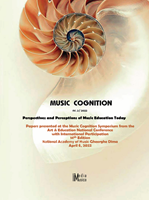Reflections on the importance of research for the activity of a Romanian traditional dance teacher "lad's dance in Romania"
Reflections on the importance of research for the activity of a Romanian traditional dance teacher "lad's dance in Romania"
Author(s): Marian-Andrei MezdreaSubject(s): Customs / Folklore, Cultural Anthropology / Ethnology, Culture and social structure , Sociology of Culture, Sociology of Art, History of Art
Published by: MediaMusica
Keywords: The Lad’s dance in Romania; Labanotation; Interactive methods of teaching lad's folk dance to children; warming up for the Lad’s dance; Joc fecioresc;
Summary/Abstract: Following the research undertaken by Prof. Dr Zamfir Dejeu in 2015, the Lad's folk dance in Romania was included on the list of UNESCO intangible national heritage. Together with six other elements: the Căluș ritual, the Doina, the traditional pottery of Horezu, Men's Group Christmas Caroling, the traditional wall-carpet craftsmanship and Marțișorul, the lad's folk dance represents the tradition and customs of the Romanian peasant. This book, "Jocul fecioresc din România" (The lad's folk dance in Romania), is the most important of Dr Zamfir Dejeu's publications because, besides structuring all the research work for UNESCO, it contains the scores of the dance melodies, as well as the transcription of the lad's dances in the international Labanotation. It is thus aimed at specialists and connoisseurs of this type of notation, but not only, and it represents good teaching material. It is the only book of its kind published in Romania. The international Labanotation contributes to understanding traditional dances from a scientific point of view by transcribing them. This work is significant for choreography teachers because it exposes different Romanian lad's folk dances, classified into nine categories, for each of the nine categories identified in prof. Dejeu's book, both musical examples and the transcription of dances in the international Labanotation are present. The book includes the scores of each melody on which the dances are performed. These reinforce the outstanding research made for this book. Firstly, the dance notation helps researchers pass on the dances as they were performed, without distortion. Secondly, ethnochoreology researchers, by transcribing the dances, can analyse them technically and in relation to the music. Feciorește rar is the most complex and rich in dance figures of all lad's dances. It can only be performed by the most skilled dancers and has a high degree of difficulty. However, it is also the most common lad's dance in most folklore dance groups in the Transylvanian area. Feciorește rar is also often seen at private events or parties, where boys and men compete in various complex dance figures. This is where improvisation comes in. The performers dancing the Feciorește rar perform the dance figures in their style.
Journal: Cogniție Muzicală
- Issue Year: I/2022
- Issue No: 1
- Page Range: 32-52
- Page Count: 21
- Language: English

